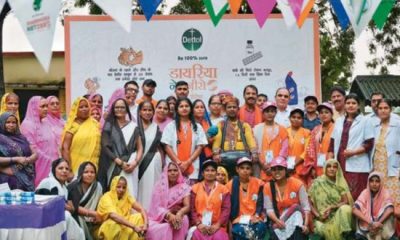New Delhi: A year and half after the Union Cabinet approved River Ganga (Rejuvenation, Protection and Management) Authorities Order in January 2016, Minister for Water Resources, River Development and Ganga Rejuvenation Uma Bharti said that it will take ten years to clean-up the river and ensure its proper ecological flow of the river. Speaking at length at a press meet held at the National Media Centre, New Delhi on June 19, Ms Bharti spoke at length about the various initiatives undertaken by the Ministry of Water Resources to address the problems facing river Ganga.
Here are the Top 5 things that Ms Bharti spoke about on the progress of rejuvenating Ganga:
- 10 Years To Clean Ganga | The Minister maintained that it will take at least 10 years to clean the Ganga and ensure proper ecological flow of the river. She said that the key problems of the river were being addressed on a regular basis and the Ministry is hopeful of solving the problems within the next 10 years.“The total time taken to ensure cleaning of Ganga and increase in its water flow will take 10 years. Though I will admit that the results expected in 2017, will now be coming in 2018 due to certain delays that we had to face. We have already ensured that activities like cremation along the river are stopped. We are continuously monitoring all the projects related to Ganga along with the state governments,” said Ms Bharti.
- New Sewage Treatment Plants | A total of 155 new sewage treatment projects have been approved across the five Ganga basin states of Uttar Pradesh, Uttarakhand, Bihar, Jharkhand and West Bengal, under Namami Gange. The National Mission for Clean Ganga (NMCG) has also proposed 963 new projects which would not only treat sewage, but also help in composting to ensure that the treated sewage can be utilised properly.
- Financial Assistance To Ensure Functioning Of STPs | Speaking on the status of sewage treatment plants (STPs), it was said that earlier, many STPs would stop functioning a few years after they began operating, due to the lack of funds from the state governments, which were responsible for maintenance of STPs. To address this, the Ministry has now included maintenance cost for 15 years from the start of operation of the plant, as a part of the funds allocated for new STPs.
- Making Ganga Villages ODF | The Ministry of Water Resources has also been instrumental in eradicating open defecation from nearly 90 per cent villages situated near the banks of Ganga, across the five basin states.
- Manual Water Quality Monitoring | The Ministry has begun manual water quality monitoring in 110 locations across the five basin states. It has also begun real time effluent monitoring in 44 locations, which would enable experts to check the levels of pollution across locations in the Ganga and report the same to the NMCG. Ms Bharti said that around 200 engineering students from various institutes will begin monitoring the Ganga for water quality and amount of pollutants.
The Minister also took the occasion to announce that she will be meeting the Uttar Pradesh Chief Minister Yogi Adityanath next week to discuss the issue of shifting tanneries from Kanpur to some other location. The 4,000 tanneries have been the main source of Ganga pollution in Kanpur, but the dependency of nearly 2 million people on these tanneries for their livelihood has cast a shadow on the decision to move these tanneries.
I will speak to the Chief Minister about the issue of Kanpur tanneries. We do not want people’s livelihoods to be affected at any cost. But industries dependent on the Ganga must also realise that without a healthy and functioning river, their operations will soon cease to exist. I will discuss the issue with the Chief Minister in detail, said Ms Bharti.
In addition to all these measures, the Ministry will also undertake the help of state governments to begin afforestation along the Ganga in selected villages and towns. Planting of trees along the Ganga was an initiative the Ministry has been planning to undertake for long and is hopeful to roll out the first afforestation drive very soon.
































